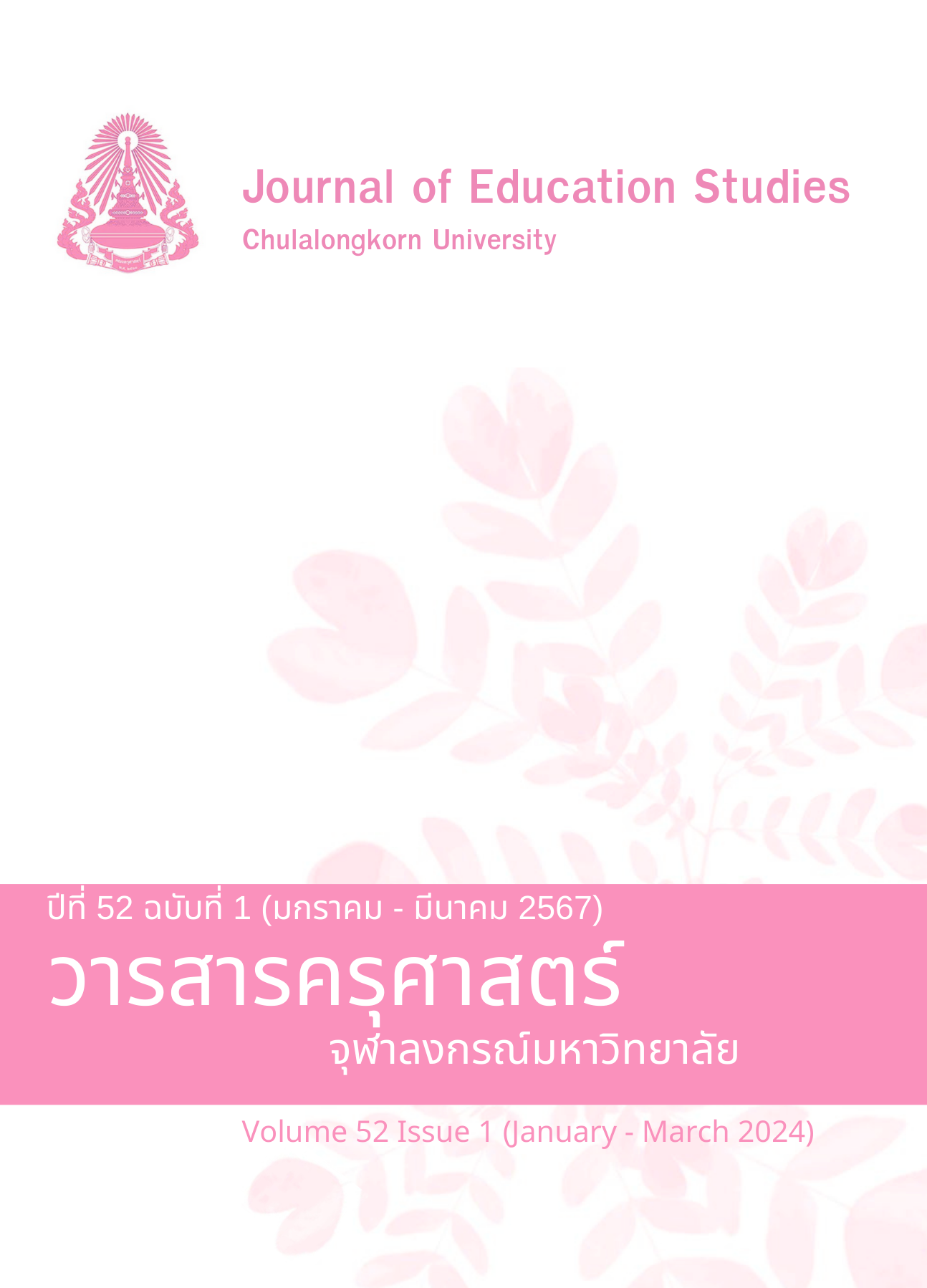Effects of Enhancing the Design Thinking Abilities of Preschoolers by Using a Three-Dimensional Creative Arts Activities Organized with the Loose Parts Concept
DOI:
https://doi.org/10.14456/educu.2024.14Keywords:
a three-dimensional creative arts activity, loose parts concept, the design thinking abilities, preschoolersAbstract
The purposes of this research were to: (1) study the effectiveness index of lesson plans using three-dimensional creative arts activities organized with the loose parts concept, and
(2) compare the design thinking abilities of preschool children before and after the experiment. The research participants consisted of 20 preschoolers aged 4-5 years by cluster random sampling. Each 45-minute experimental session was executed five times a week for a total period of six weeks. The lesson plans were implemented through four main phases: 1) a warm-up and problem-definition scenario, 2) exploration and goal-setting, 3) implementation of activities and creation of artwork, and 4) summary and reflection. The research instrument used was a lesson plan of three-dimensional creative arts activities organized with the loose parts concept and a performance rubric for the preschoolers’ design thinking abilities. Statistical analyzed using an effectiveness index, mean, standard deviation, and t-test. The major findings were as follows: 1) the effectiveness index of the lesson plans was equal to 0.7099, indicating that the participants showed a 70.99 percent improvement in their design thinking abilities; and 2) the design thinking abilities of preschoolers after the experiment were significantly higher than before the experiment at the .05 level of significance. The results of this research indicate that using a three-dimensional creative arts activities organized with the loose parts concept can enhance the design thinking abilities of preschoolers.
References
ภาษาไทย
กมลวรรณ ศรีสำราญ และ อรพรรณ บุตรกตัญญู. (2562). ผลการใช้กิจกรรมเล่นวัสดุสร้างสรรค์อย่างมีจุดมุ่งหมายที่มีต่อการตระหนักรู้และเข้าใจตนเองของเด็กปฐมวัย. วารสารจันทรเกษมสาร, 25(2), 34-47.
กระทรวงศึกษาธิการ. (2560). หลักสูตรการศึกษาปฐมวัย พุทธศักราช 2560. ชุมนุมสหกรณ์การเกษตรแห่งประเทศไทย.
จันทร์เพ็ญ ไชยมงคล และ ปัทมาวดี เล่ห์มงคล. (2564). ผลของการจัดกิจกรรมการเล่นวัสดุสร้างสรรค์ที่มีต่อทักษะพื้นฐานทางคณิตศาสตร์ด้านความรู้สึกเชิงจำนวนสำหรับเด็กปฐมวัย. วารสารวิชาการมหาวิทยาลัยปทุมธานี, 13(2), 468-484.
ณัฏฐ์ชญา หอมจัด. (2563). การพัฒนาความคิดสร้างสรรค์ของเด็กปฐมวัยโดยการจัดกิจกรรมศิลปะสร้างสรรค์ ตามแนวคิดของ Williams. [วิทยานิพนธ์มหาบัณฑิต]. มหาวิทยาลัยราชภัฏสกลนคร.
ณัฐกฤตา ไทยวงษ์. (2562). การศึกษาผลการจัดประสบการณ์ตามแนวคิดเชิงออกแบบที่มีต่อความคิดสร้างสรรค์และความสามารถในการแก้ปัญหาของเด็กปฐมวัย. [วิทยานิพนธ์มหาบัณฑิต]. มหาวิทยาลัยราชภัฏพระนครศรีอยุธยา.
วาทินี บรรจง. (2556). ผลของการจัดประสบการณ์ศิลปะโดยบูรณาการแนวคิดเชิงออกแบบต่อความคิดสร้างสรรค์ของเด็กอนุบาล. [วิทยานิพนธ์มหาบัณฑิต]. จุฬาลงกรณ์มหาวิทยาลัย.
วีณา ประชากูล. (2557). ผลการเล่นวัสดุปลายเปิดที่มีต่อความคิดสร้างสรรค์ของเด็กปฐมวัย. [วิทยานิพนธ์มหาบัณฑิต]. มหาวิทยาลัยศรีนครินทรวิโรฒ.
ศศิลักษณ์ ขยันกิจ และ ธันยา พิทธยาพิทักษ์. (2564). คู่มือ สื่อ เล่น สร้าง เพื่อพัฒนาการคิดของเด็กปฐมวัย
(พิมพ์ครั้งที่ 2). กู๊ดเฮด พริ้นท์ติ้ง แอนด์ แพคเกจจิ้ง กรุ๊ป.
สำนักวิชาการและมาตรฐานการศึกษา. (2565). รายงานผลการประเมินพัฒนาการนักเรียนที่จบหลักสูตร
การศึกษาปฐมวัยพุทธศักราช 2560 ปีการศึกษา 2563. กระทรวงศึกษาธิการ.
สุวิธิดา จรุงเกียรติกุล. (2561). ทักษะการเรียนรู้ในศตวรรษที่ 21. https://www.trueplookpanya.com/education/content/66054/-teaartedu-teaartteaarttea.
ภาษาอังกฤษ
Arnheim, R. (1983). A study of composition in the visual arts. Journal of Aesthetics and Art Criticism, 41(4), 448-450.
Brown, T. (2008). Design thinking. Harvard Business Review, 86(6), 84-92.
Brown, T. (2009). Change by design. Harper Collins.
Cross, N. (2006). Designerly ways of knowing. Springer Verlag.
Lawson, B. (2012). What designers know. Routledge.
Marnfah, Rd. (2017). Summary of meanings methods and knowledge related to design thinking. https://medium.com/marnfahhh/.
Peterson, H. T. (1958). Kindergarten the key to child growth. Exposition Press.
Ramli, F. M. (2020). An exploration of thematic sketch through visual arts activities towards the preschool children. Southeast Asia Early Childhood Journal, 9(2), 132-134.
Simon, N. (1970). How not to cheat children the theory of loose parts. Landscape Architecture Journal, 62(1), 30-34.
Simon, A. (2009). Understanding the natural and artificial worlds. In H. B. Clark & D. E. Brody (Eds.), Design Studies A Reader (pp. 106-109). Oxford Berg.
Stanford Design School. (2010). bootcamp bootleg. https://static1.squarespace.com/static/57c6b79629687fde090a0fdd/t/58890239db29d6cc6c3338f7/1485374014340/METHODCARDS-v3-slim.pdf.
Torrance, E. P. (1962). Guiding creative talent. Prentice Hall.
Vanada, D. (2014). Practically creative the role of design thinking as an improved paradigm for 21st century art education. Techne Series, 21(2), 21–33.
Downloads
Published
How to Cite
Issue
Section
License

This work is licensed under a Creative Commons Attribution-NonCommercial-NoDerivatives 4.0 International License.




